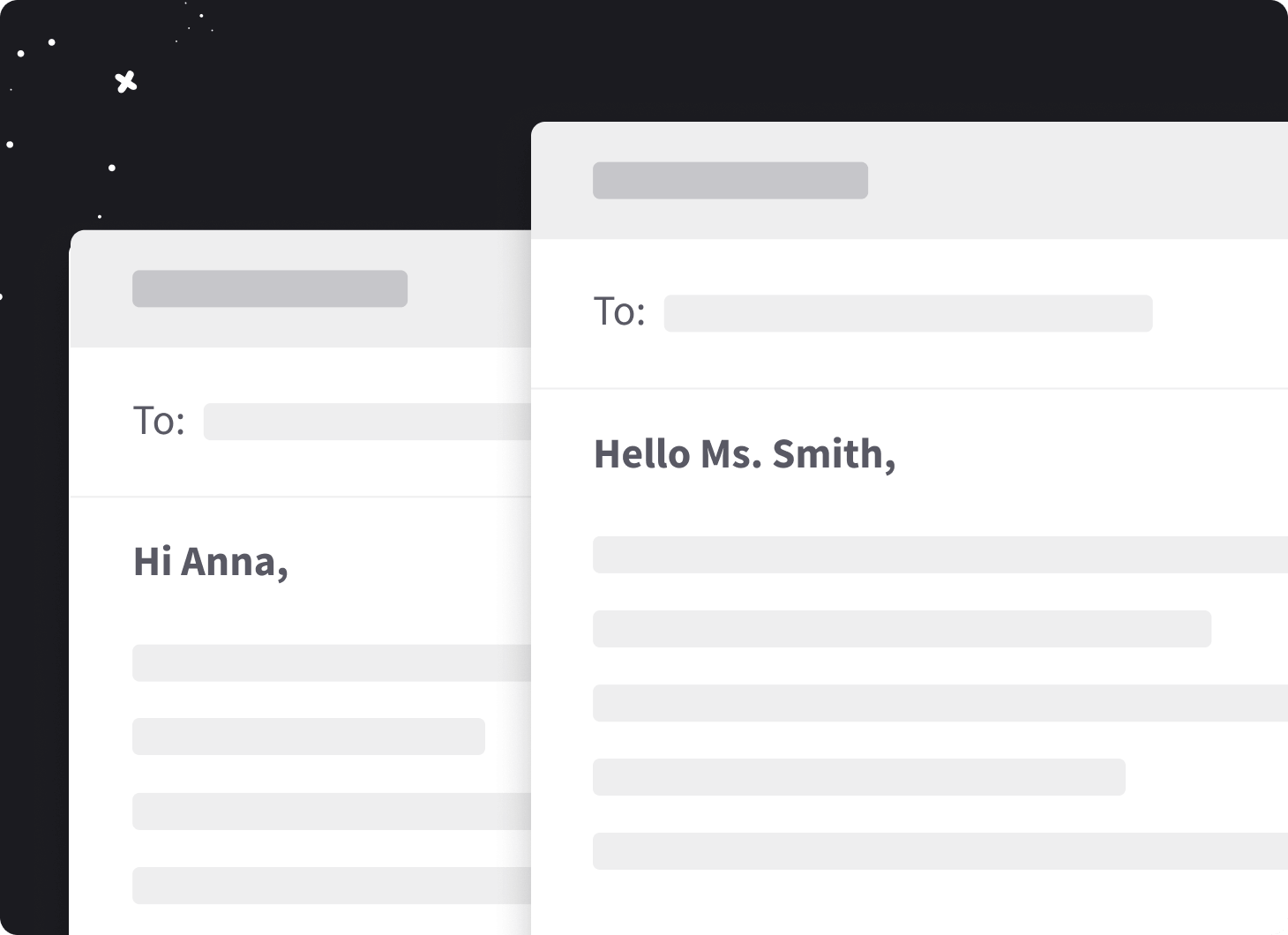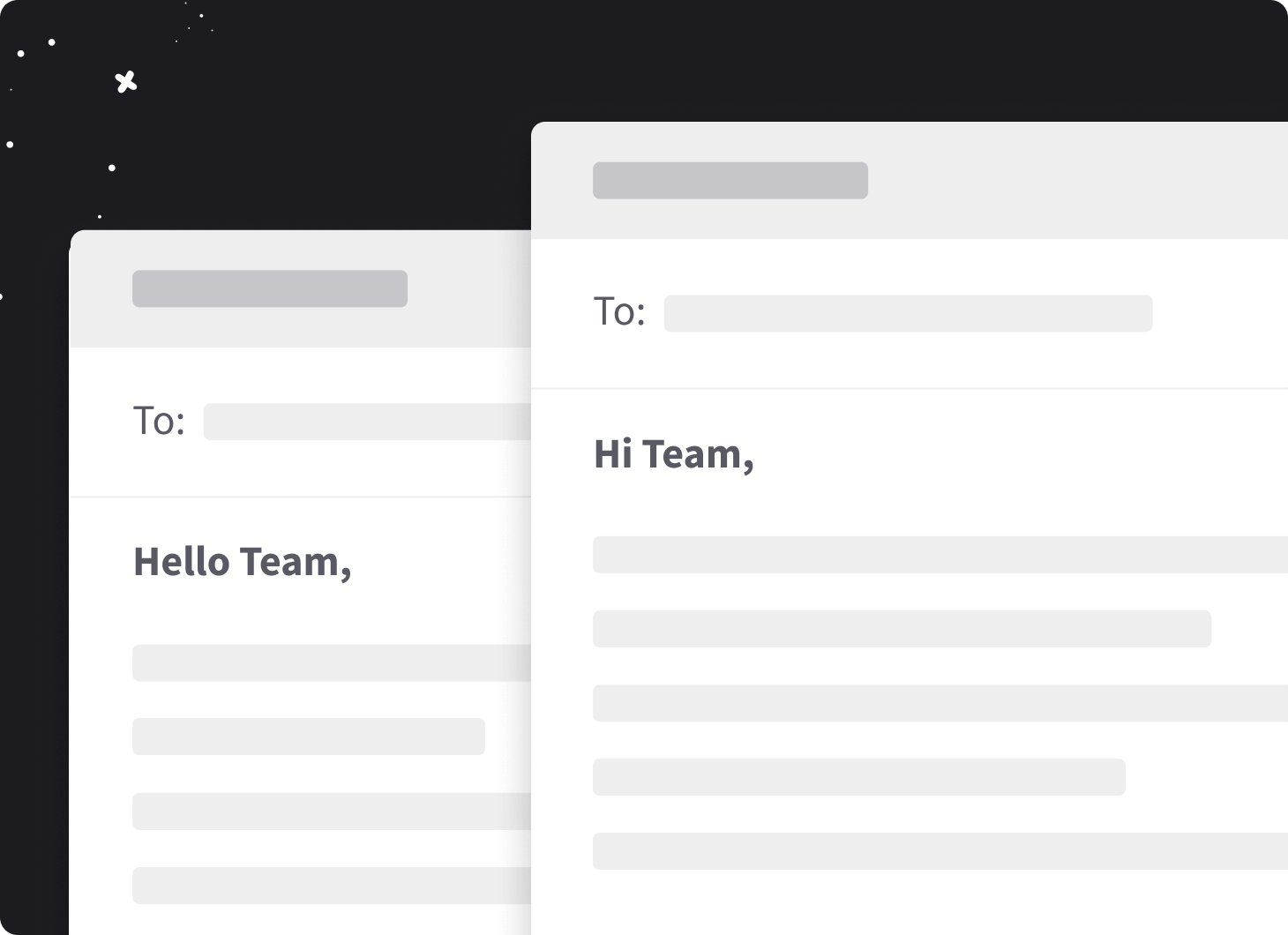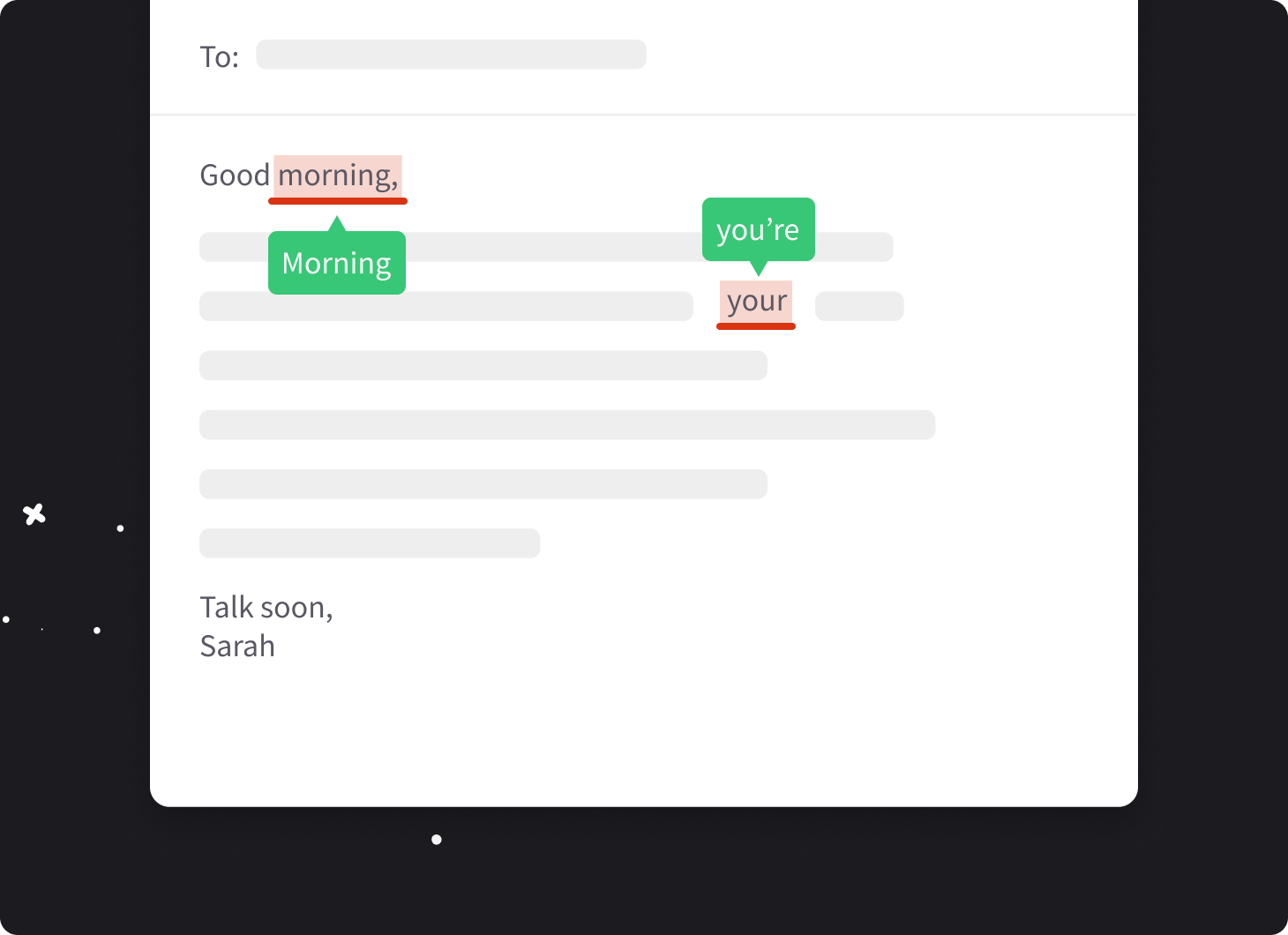


Busy supporting customers? Not anymore.
Watch hands-on webinar on workflows and easily automate your work in just five minutes!
We’ve all been there: struggling with how to start a professional email. Should we use the recipient’s full name and title? Which greeting should I choose? How can I make it not sound too casual or too formal? Should I even worry about this tiny little part of an email?
Different business situations require different approaches. However, there are some general rules that can save you time and energy.
We already know how to give your emails a clear structure. Now, it’s time to take a look at popular email openings and find the ones that are the most appropriate in a business context. Feel free to choose the ones that match your personality and writing style. It’s always a great idea to find a balance between sounding professional and being yourself.
Let’s dive in and learn more about how to start an email and the most popular email greetings.
We all want to seem professional and competent. However, professionalism doesn’t mean only using formal language. The most standard way to start a professional email is, of course, to use the appropriate greeting and the name of the person you’re addressing your email to.
Dear Mark, (…)
Dear Mr. Jones, (…)
It’s a good idea to start your email neutrally. You simply use the recipient’s first name or their family name with Mr./Ms.
Hi Anna, (…)
Hello Ms. Smith, (…)

This is another neutral way of starting an email. It’s less formal than the previous one, but it’s still widely used in the business world.
You can also choose from general greetings:
Good Morning, (…)
Good Afternoon, (…)
Good Evening, (…)
Speaking of general greetings, it’s better to skip the most informal ones: Hey, Howdy, Yo, Heya, etc. They’re not the best choice in a business context, even if your email isn’t entirely written in a formal tone.
⚒️ Control your communication patterns with HelpDesk. Analyze all tickets with recipients, draw conclusions, and adjust your messaging.
Sign up for the 14-day free trial!
There are two things you can’t get back: time and the first impression you make on someone. When you meet someone in person, you shake hands, exchange names, and then you move on to the conversation. It’s nice and easy. Online relationships are created differently, but your first impression still matters.
There are two things you can’t get back: time and the first impression you make on someone.
You start to appreciate the good old handshake and face-to-face talk when you need to approach someone and sort things out. Imagine you have to email someone you don’t know asking for a job, advice, an opinion, or about working together. How do you start your message? How can you introduce yourself in the email so that it’s not awkward? Learn more about the seven steps you should take to smoothly get down to business.

According to research, 47% of emails are opened based on the subject line alone. I hope this convinces you to polish the subject of your message. Give yourself some time to come up with a subject that will boost open rates. Make it a performance piece. In the email subject you can:
Refer to having a mutual acquaintance or common interest.
Briefly appreciate the work or achievements of your recipient.
Mention your name, job title, or the company’s name that you work for.
Encourage them to take a specific action. This could be a phone call, meeting, lunch, or another initiative.
You have about 30 characters to motivate your recipient to open your email, so do your best.
You’re lucky. In this Learning Space lesson, there’s a list with the best email greetings. Personalize your greeting. If you use the recipient’s name here, check it carefully to make sure it’s correct for your own good.
🔥 Be consistent in your greetings with canned responses. Always start the conversation the same way, even if multiple individuals on the team.
I know that the message should be mainly focused on the recipient, and you should avoid talking about yourself. However, who likes to talk to strangers? Nobody does. Say a few words about yourself so the recipient wants to deal with you.
Adjust the way you present yourself to the person and its context. Choose your words wisely. To make it easier, imagine you’re meeting a key manager you want to work with or a person who likes to travel, just like you. How would you introduce yourself in person? I guess you would use different phrases for your intro. Try to recreate your speaking style in your email.
Bring up the recipient’s story here, and make it more personal. You can refer to an interesting article, winning an industry competition, a promotion at work, an insightful post on LinkedIn, or a mind-blowing speech at a conference. Make your recipient feel special and appreciated. This can’t hurt but it will also increase the chances for a positive response.
Surely you have your reasons for writing the email message. However, you shouldn’t be selfish and only talk about your concerns. Shape your message so that it brings more benefits to your recipient than to you. There’s a fundamental law of social psychology called the principle of reciprocity. If you give something of value, people are more willing to respond the same way. Your message must be beneficial and offer attractive opportunities.
Add the call-to-action, and do everything you can to make it easy to understand. Make sure that your recipient is fully aware of your needs. You can also include attachments or links to resources to be more specific. Remember, don’t make a demand, but make a polite request. Thank your recipient for taking the time to read your message.
Personalize your closing to reflect the relationship you have with the recipient. Check out the list of the best email closings, and choose one according to your needs.
🔥 Be consistent in your closings with canned responses. Always end the conversation the same way, even if multiple individuals are on the team.
You can enhance your credibility by linking to your social media profiles, your blogs, or other places with information about you. Share trusted sources so that your recipient doesn’t have to do extra research. Also, make sure you proofread. An error-free email message will be more likely to make a good impression.
Writing emails to your future employer with a cover letter included is another story. Start the conversation with the recruiter in a professional way. But how do you do that? How should you address a recruiter when sending your resume or CV?

Let’s assume you don’t know the name of the email recipient. Here are some useful expressions for this situation.
Dear Recruiter, (…)
This is a fairly neutral greeting for anyone contacting a recruiter when you don’t know the name of that person.
Dear Hiring Team, (…)
This is a good alternative to the first opening. With this phrase, you include more people who are involved in the hiring process.
Dear Hiring Manager, (…)
This one sounds more formal, but it’s still a good choice for a job application email. This email fits well in a corporate environment with a more official company structure.
Hi [company name], (…)
Hi [company name] Team, (…)
I would use this greeting for a company that seems to have a more casual work environment. These greetings underline the fact that you’d like to join the company because you’re addressing the entire team. For example, if a company has strong employer branding with a strong “we’re a tribe” attitude, I’d definitely go with this one.
Subscribe and get a guide!
Join the mailing list and get a practical guide to email communication.
Addressing one person can be tricky, but what about an entire group? Let’s figure out how to address a group of people, especially when you don’t know them. Here are some examples that are useful in different contexts.
Hello Team, (…)
Hi Team, (…)

Use this one if you’re joining a team or if you’re creating a new project team. It’s a great way to include everyone who is involved with the project.
Dear X Team, (…)
When you’re not part of the company, try addressing the team in this way.
Hi everyone, (…)
This is a fairly neutral greeting to use whenever there’s an unspecified group of people.
Check out this list if you’re wondering about how to start an email. Here, you’ll find the most common expressions to greet someone in an email message. Copy and paste one of them to begin the conversation.
GREETING | TYPE OF MESSAGE |
Hello | A universal and neutral phrase. You can use it for formal and informal communication. It's one of the most popular greetings. |
Hello [Name] | A universal and neutral phrase. You can use it for formal and informal communication. By adding a name, communication becomes more direct. |
Hello everyone | A universal and neutral phrase. You can use it when you write to a group of people or when you don't know the exact names of the people you’re writing to. You avoid using a gender. |
Hi [Name] | A phrase recommended for semi-formal or informal communication. Indeed, it's friendly, but avoid it in formal communication because it can be considered too direct and, therefore, rude. |
Hi there | A phrase recommended for semi-formal or informal communication. Use it when you write to a group of people or when you don't know the exact names of the people you’re writing to. You can show good intentions and avoid using a gender. |
Good Morning/Afternoon/Evening | A universal and neutral phrase. You can use it for formal and informal communication. Apply it when you know the time your recipient will be receiving your message. It's also good to think about whether your recipients will read the message as soon as you send it. Otherwise, it'll be weird when they read it in the evening and the greeting is "Good Morning." |
Dear [Name] | A universal and neutral phrase. It's very polite. You can use it for formal and informal communication. By adding a name, communication becomes more direct. |
Dear Sender | A universal and neutral phrase. You can use it for formal communication. Apply it when you don't know the exact name of the recipient. Also, it doesn't indicate a gender. |
Greetings | A phrase recommended for semi-formal or informal communication. It's simple and kind. Use it when you write a group of people or when you don't know the exact names of the people you’re writing to. You can show good intentions and avoid using a gender. |
Dear Sir or Madam | A formal phrase, but it's considered outdated. Apply this in official communication and when you don't know the exact names of the people you’re writing to. You have to be careful here because you include the gender of your recipient. Use it only if the recipient’s company culture requires it. |
To Whom It May Concern | A formal phrase, but it's considered stiff. Apply this in official communication and when you don't know the exact names of the people you’re writing to. It's a very general greeting, so recipients may assume that the message isn’t important. Use it only if the recipient’s company culture requires it. |
There are some greetings that can make you sound too formal or aren’t specific enough. It’s not a mistake to use them, but it has to be a conscious choice.
To whom it may concern, (…)
Dear Sir or Madam, (…)
n some cases, you may want to sound really formal. In that’s the case, go ahead and use these greetings. However, in any other business context, it’s better to stick to the salutations that are professional but still casual.
Hi there, (…)
This greeting is rather impersonal and generic. Instead, I would go with one of the alternatives presented above.
All, (…)
This email opening seems to be very popular in the corporate world. However, it’s not a bad idea to add an actual greeting and go with something like, “Hi everyone.”
Keeping the quality of your writing high is essential. Almost everyone uses Grammarly or other spell checker tools, and you should too. Taking the extra time to eliminate typos and check your grammar will make your email easier to read.

Below, you’ll find examples of email openings that may cause confusion even if you have a program that checks your spelling.
Mr. or Mr?
Ms. or Ms?
Dr. or Dr?
This difference is dictated by the diversity of the English language. In American English, there should be a period, while in British English, there shouldn’t.
Good Morning, (…)
Good Afternoon, (…)
Good Evening, (…)
Remember to capitalize both words in these greetings, i.e., “Good” and “Morning.”
Dear Isabelle, (…)
Dear Isabel, (…)
Dear Mr. Miller, (…)
Don’t forget to double- or even triple-check the correct spelling of the recipient’s name. In the international business world, there is a diversity of names that have different spelling depending on where the person comes from. It’s an obvious, yet often skipped, email writing tip.
Here’s a list of phrases that may be useful if you don’t know what the first sentence of your email should be.
EMAIL OPENING LINES EXAMPLES |
|---|
|
However, the best strategy is to make the first sentence about the reader. Find something that makes your message easy to relate to.
For example:
EMAIL OPENING LINES WITH REFERENCE TO THE RECIPIENT |
|---|
|
No more wondering how to start your email. In HelpDesk, you can save the best opening lines as a canned response. Test HelpDesk for 14 days for free and add the perfect line to your message with a single click.
In business emails, you need to stay professional. However, that doesn’t mean you have to be super formal and use sentences you’d never use in the real world. With these email greetings, you’ll always know how to start your next important business email.
Adjust your tone to the recipient.
Check your spelling twice.
Remember about capitalization in greetings.
Get recipient’s attention with the first sentence.
Check out the next lesson to learn how to close an email and optimize the last line to get a response.
In the next lesson
How to End an Email With a Professional Closing
You already know how to create an efficient email structure and how to start an email. Let’s revise how you can close your business email to achieve your goal.
Go to lesson 3Subscription with a gift!
Join the mailing list to get a special ebook on email communication.
Try HelpDesk for free
For quick and intuitive tickets management